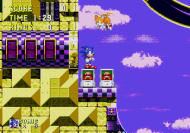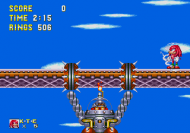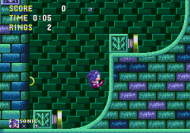Main Features
The following is a summary of some of the most notable changes included in Sonic 3 Complete. Please see the Full List of Changes and Options section for a more detailed list.
Sonic 3 Design and Presentation

The original Launch Base layout in action.
The primary inspiration for the project's creation was the idea that Sonic 3's presentation got a lot of things right that Sonic & Knuckles changed for the worse. As such, the default setup for Sonic 3 Complete restores Sonic 3's audio and visual style for the whole game, including, among other things, the original main game themes, Knuckles' iconic Jacksonesque drumbeat and associated miniboss theme, the reflective lack of music in zone transitions, the original title cards and a lack of "and Knuckles!" exclamations glued in wherever possible.
For the Sonic 3 zones, the original object layouts are available, and are used by default in most cases. Launch Base's tricky traps are hence restored to their full power, and watching your step during the Hydrocity wall chase is well advised.
Perhaps most notably of all, the transition between the Sonic 3 and Sonic & Knuckles zones is much improved, restoring Sonic 3's final boss Big Arm for Sonic and Tails at the end of Launch Base, and providing a cutscene based on the Sonic & Knuckles title screen to bridge the gap.
For those who aren't so set on Sonic 3 being the better half, it is possible to revert most of these changes using menu options or patches, and even to apply different musical configurations when playing the separate Sonic 3 and Sonic & Knuckles halves.
Zone Order Restoration
It is commonly understood that Flying Battery Zone was originally intended to be played between Carnival Night and Icecap, but was moved around late in the development of Sonic 3. Sonic 3 Complete features an option to restore it to that position, with a suitably altered night sky, and a further optional change to the indoor colour scheme to match the unused save screen icon from Sonic 3 (which has also been restored). When moving from Flying Battery to Icecap, the snowboard sequence involves the broken exit door from Flying Battery, as was once planned. Mushroom Hill also takes its name from the Sonic 3 level select, Mushroom Valley, and a new transition takes you from there straight to Sandopolis if Flying Battery is moved away from its normal position.
Tweaks and Fixes

No more last-minute cast changes.
A large number of tweaks and bugfixes have been made to smooth over rare and common issues in the game. Most bugfixes are always on and cannot be disabled, but subjective feature tweaks can mostly be reverted to the original behavior.
Rather than being the third wheel, the Tails experience has been upgraded: he now has his own intro sequence, like Sonic and Knuckles (whose Sonic & Knuckles intro has been moved to the start of the full game in Angel Island), his own continue screen, and his own colors on the results screen. A feature borrowed from Sonic 1 2013 allows Sonic, in a Sonic and Tails game, to have AI Tails start flying by holding up while double-jumping; Sonic can then be picked up by Tails and control Tails' flight, allowing him to explore further without having a second player present. The controls for Tails' flight in this mode can be toggled between Sonic 1 2013-style, in which player 1 directly controls Tails and down must be held while jumping to detach, or traditional Sonic 3-style as used during the Marble Garden boss, where player 1 can use the d-pad to direct Tails.
One significant change affects activation of super forms; this now requires pressing a different button from the one last used to jump to transform in mid-air, allowing for usage of all double-jump abilities without forced transformation, and allowing Sonic to transform even if he has a shield. The same alternate-button double-jump can be used to cancel a super transformation. While transformed, rather than being forced to listen to the invincibility theme on endless loop, the default behavior is to speed up the existing level music as if you had super sneakers. All of these changes can be reversed individually in the menu if preferred.
Once you do activate Super or Hyper Sonic, you'll find that unlike the original game, the vast majority of his graphics now correctly reflect his change in form (though this does not currently extend to the Sonic 1 or Sonic 2 alternative sprite patches).
Bugfixes cover all sorts of issues, from common annoyances (such as Robotnik showing up for Knuckles in Flying Battery, or the unreadable HUD text in Angel Island) to tiny details (such as mapping frames being slightly misaligned, or doubled-up rings in the same spot). Since each available game in the collection runs from the same engine, all fixes are available whether playing Sonic 3, Sonic & Knuckles or Complete mode within the collection; as such, the included version of Sonic 3 is much improved over the original due to inheriting additional fixes present in Sonic & Knuckles. (The included Blue Sphere now allows you to play as Tails, too, and the same can be achieved in Sonic & Knuckles mode via debug cheats.)
Please see the Full List of Changes and Options for a more thorough listing. Please bear in mind that there are still many bugs from the original game in evidence, although many of the more problematic issues have been taken care of.
More Music Options
In addition to switching between Sonic 3 and Sonic & Knuckles music, ValleyBell has created Mega Drive versions of the additional tracks exclusive to Sonic & Knuckles Collection, which can be used in place of the original Mega Drive tracks; the unused theme from that collection is available as alternative music for Super Sonic. Music based on the classic theme used in Sonic 1 and Sonic 2 is also available as an alternative.
Alternative Gameplay and Sonic Jam features

Easy mode springs - the antithesis of the
Sonic 3 version.
Sonic Jam's additional Easy and Normal difficulty modes are available, with their corresponding object layouts, slower special stages, and in the case of the former, reduced act count and easier bosses. These features are complemented by a new Casual Gameplay option, designed by Hayate and used in his "Casual" hacks, which allows game to be played without fear of death, for novices or a quick blast.
The options menu allows Sonic's control method to be changed from his Sonic 3-style to mimic other games in the classic series. If you think the shield moves make life too easy, or you want a peelout move and unlocked roll jump in Sonic CD-style, these options provide an alternate experience.
Additional Patches
Taking the classic experience further, it is even possible to swap in sprite sets of Sonic and Tails that closely mimic their looks from Sonic 1 or Sonic 2, as well as reinstate the classic shields and/or monitors in place of their updated forms. The additional sprites used in Sonic 3 that never existed for those games have been faithfully recreated based on the available artwork. Due to the large volume of data involved in these changes, these options - along with a few other bells and whistles - are only available via the external ROM customiser, or through the IPS patches supplied below.